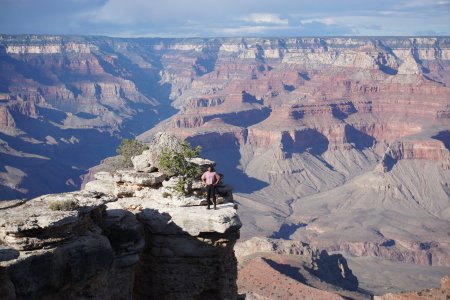Ecology, by my definition today, is the study of the phenomena, relationships, patterns and processes which constitute this living and breathing world which we all call home. Its reach is boundless, and the angles through which to look at ecological processes are diverse and span all academic disciplines. It is emerging as the central focus of the present day.
Scientific studies of ecology have a long history, and increasingly abound with mathematics. The field of mathematical ecology brings analytical tools from mathematics to try and distil the complex and mysterious relationships involved in how a snow leopard navigates the local topography of a Himalayan valley, how the distribution of marbled cats in Sabah is influenced by the geometries of tropical forest cover, or how the spatiotemporal flux of elephant movement relates to seasonal variation in weather patterns throughout southern Africa.
My doctoral research has been a metamorphic journey of ecology, starting with mathematics and wildlife conservation. This work has been with both the Mathematical Institute and the Wildlife Conservation Research Unit (WildCRU) in Oxford, kindly supervised by Philip Maini and Sam Cushman. I began by exploring novel methods to understand complex and high-dimensional patterns in data sets gathered from camera traps in Borneo. This involved recruiting ideas from the mathematical fields of topology and geometry to look at the distribution of species like the orangutan and clouded leopard, in relation to environmental conditions like elevation and human presence. I later shifted focus to studying movement paths of the African lion in southern-central Africa, analysing the mathematical underpinnings of concepts in ecological science like 'landscape connectivity' and 'landscape resistance', and developing a new individual-based model for mapping animal movement and evaluating landscape connectivity methods.
Around this time - and thoroughly precipitated by reading David Abram's landmark book The Spell of the Sensuous - my engagement with ecology expanded beyond mathematical modelling, opening to the rich insights and work developed in geography, anthropology, and other environmental social sciences. This arose from a growing realisation that the mathematical tools currently employed in ecology are greatly limited by certain assumptions which are entirely unexamined and unobserved in mainstream ecological modelling. Fundamentally, what became apparent is that how we understand 'nature' and our place within it will most deeply determine how beneficial our mathematics will be for our nonhuman friends and this rich and beautiful world. Do we see the natural world as separate from us, a suite of resources to abstractly map and govern with the 'perfect' scientific models? Or do we realise, and express in our academic work, that we are thoroughly part of the world which we study; that we can be at home in our bodies and the countless ecological processes within and around us; that much of the ecological difficulty facing us in the present day is a manifestation of how we relate to each other, to the land, to the more-than-human world in which we live?
Big questions, many answers of which can be found in a diversity of human cultures and academic disciplines. The journey of research for my doctorate has shown me that our own personal and collective answers to these questions, whether overtly asked or left implicit, have great influence on mathematical and scientific approaches to the environment, and the ripple effects they create. I slept in a tent during my third year of research, which brought me to face with these questions in quite a mind-expanding way – and as the owls hooted above me, as the badgers snuffled around my tent, and as the seasons danced their cyclical tune, I felt that the second of the two understandings of nature suggested above was more true to my emerging sense of the world.
This constellation of experiences manifested in my research by guiding me to an interdisciplinary collaboration between mathematics, ecological science and geography, involving my supervisor Sam, and three geographers – Jonny, Oscar and Tim. We investigated the precise ways in which popular connectivity models based on the framework of landscape resistance (mentioned above) are reductionist in their mechanistic approach to ecological relationships, to the extent that many fundamental dynamics of animal movement are ignored and these models lose effectiveness for application to wildlife conservation. The conversations which formed this work brought me to deeply examine the ways in which mathematics is deployed to quantify ecological processes, and creatively explore approaches to develop models which attend more fully to the liveliness and richness of animal movement.
Now in my final year, I am tying together this exploration into a thesis called Mathematical Ecology in a More-Than-Human World. But I know that my love for mathematics, ecology, fellow humans, and all our nonhuman friends, will be lifelong – in the coming years, I am hoping to continue my investigations into mathematics and ecology, informed and enriched by the wonderful people and interdisciplinary work which I have been blessed to meet during my time studying here in Oxford. I do not know what shape these future studies will take, but the ecological challenges of the present day move me to explore ways of bringing mathematics to speak more fully to the rich and holistic understandings of ecology I have encountered in geography and anthropology during my doctoral research. And with love, I bow to my family, friends and teachers, without whom none of this would have been possible.
Further reading:
Smoothing and the environmental manifold
Pathwalker: A New Individual-Based Movement Model for Conservation Science and Connectivity Modelling
Moving beyond landscape resistance: considerations for the future of connectivity modelling and conservation science
Connectivity modelling in conservation science: a comparative evaluation
Minimal ecologies
Siddharth Unnithan Kumar is a postgraduate student in Oxford Mathematics. The photograph above was taken at the Grand Canyon, Arizona in September 2022.


